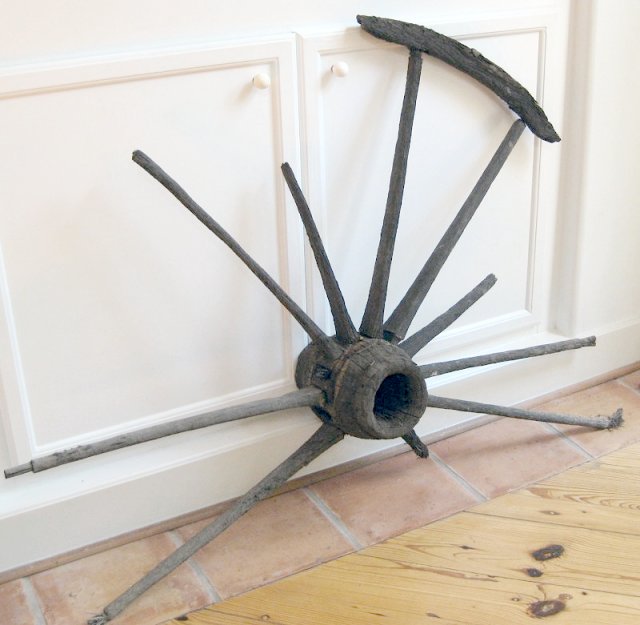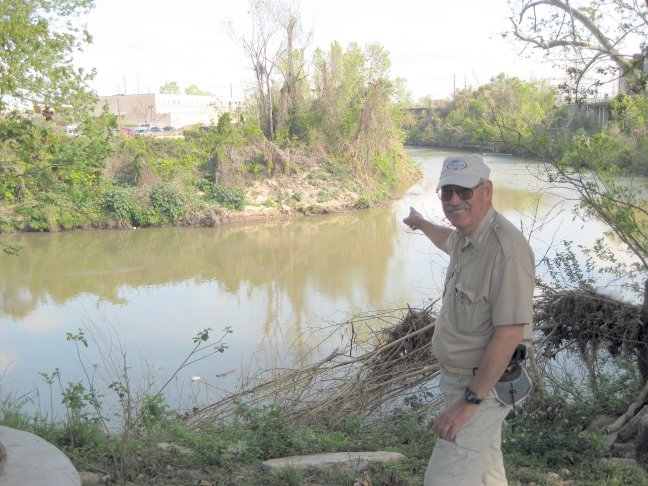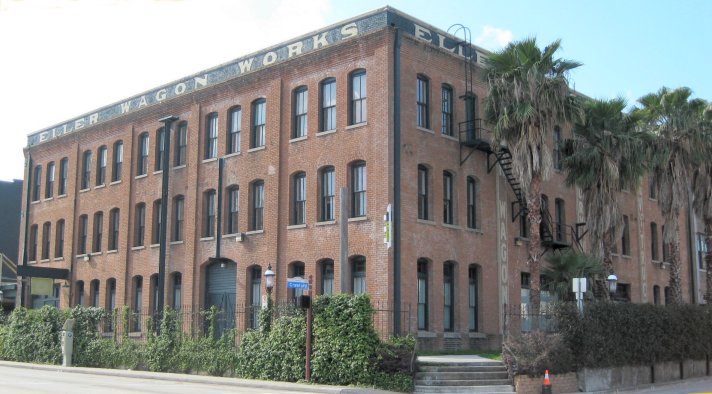 A few
weeks ago one of our friends called to say he had found something
interesting while exploring the banks of Buffalo Bayou. This discovery
was made a few months after Hurricane Ike had churned up the waters and
eroded some of the banks along the bayou.
A few
weeks ago one of our friends called to say he had found something
interesting while exploring the banks of Buffalo Bayou. This discovery
was made a few months after Hurricane Ike had churned up the waters and
eroded some of the banks along the bayou. What our friend found was part of a most interesting wagon wheel that just begs more research.
 The wagon wheel was discovered about one quarter mile
downstream from Allen’s Landing and across from the Gable Street
Power plant in the Arsenal Block curve.
The wagon wheel was discovered about one quarter mile
downstream from Allen’s Landing and across from the Gable Street
Power plant in the Arsenal Block curve. Research into Houston’s Sanborn Insurance Maps indicates that there was a wagon wheel maker (Mosehart & Keller Co. Wagon and Carriage Factory) just south of the bayou at Caroline Street and Franklin Avenue operating in the late 1800’s and early 1900s. However, an existing building in the 100 block of Crawford Street, at Commerce Avenue, is the former Eller Wagon Works that dates from 1909.
 Further adding to the mystery of the wagon wheel, a
newspaper article from the February 25, 1896 issue of the Galveston
Daily News says that in its regular weekly meeting, the Houston City
Council passed a resolution that trash and garbage was allowed to be
disposed of in the gully at the end of Crawford Street, which is just a
block away from the Eller Wagon Works.
Further adding to the mystery of the wagon wheel, a
newspaper article from the February 25, 1896 issue of the Galveston
Daily News says that in its regular weekly meeting, the Houston City
Council passed a resolution that trash and garbage was allowed to be
disposed of in the gully at the end of Crawford Street, which is just a
block away from the Eller Wagon Works. The arsenal block gully was right at the end of Crawford Street. There is no doubt that the news article was referring to that gully as a dump. The carriage maker and repair shop could have been cleaning out their bin of replaced carriage wheels and simply tossed our wheel into the dump. Slowly, over time, the wheel settled to the bottom of the gully's mud, even after the gully was filled in. The wheel lay in the mud for a century until the rains of Hurricane Ike scoured the bottom mud of the bayou and released the wheel from its muddy bonds. It floated up and settled gently on the opposite bank as the water subsided. There it lay, waiting to tell its story.
Are these garbage disposal practices of the late 19th century still impacting today’s Buffalo Bayou as artifacts such as this wagon wheel are washed out of former trash gullies after big storms?
Here’s what we do know about the wagon wheel.
The wheel is 56 inches in diameter.
The spokes are 22 in length.
The hub appears to be hand carved and not turned on a lathe. The axle hole is approximately 2 inches in diameter and the outside measurements of the hub are 10 long and 8 in diameter.
The outer rim surface of the felloe (the exterior rim or a segment of the rim of a wheel supported by the spokes) measures 1 ¼ inches and the rim is 2 inches thick.
We have sought information from many websites dedicated to wagon wheels – and there are a few! None of the wheels shown on the web match exactly the measurements of this wagon wheel. We’ve concluded that it could possibly be from an ice wagon (there was an ice plant nearby), a fruit and vegetable wagon (on its way to Market Square to sell goods), an ambulance, a surrey or wagon for personal use.
If anyone out there has information to share about this wagon wheel, we’d love to hear from you. And if you’ve pulled anything interesting from the Bayou, send us a photo and we’ll try to help you research it.